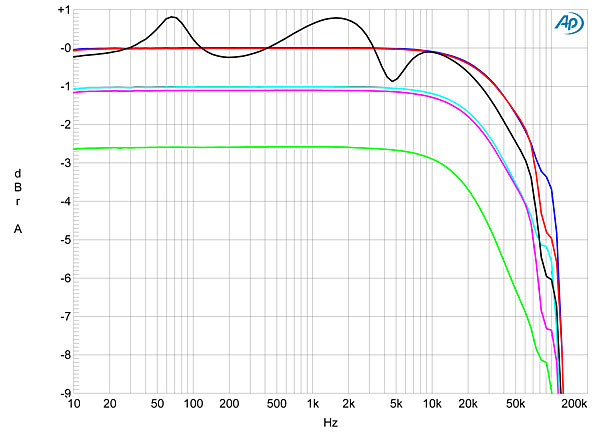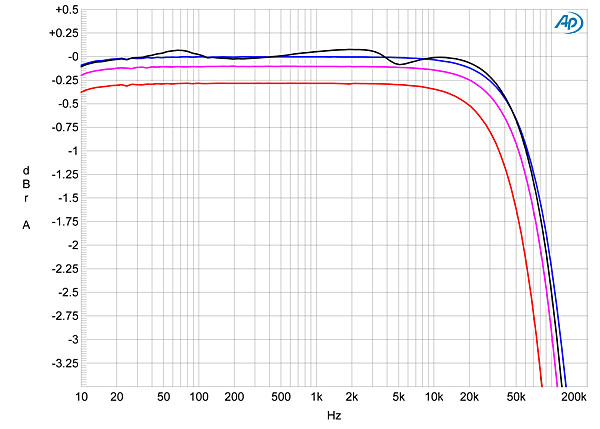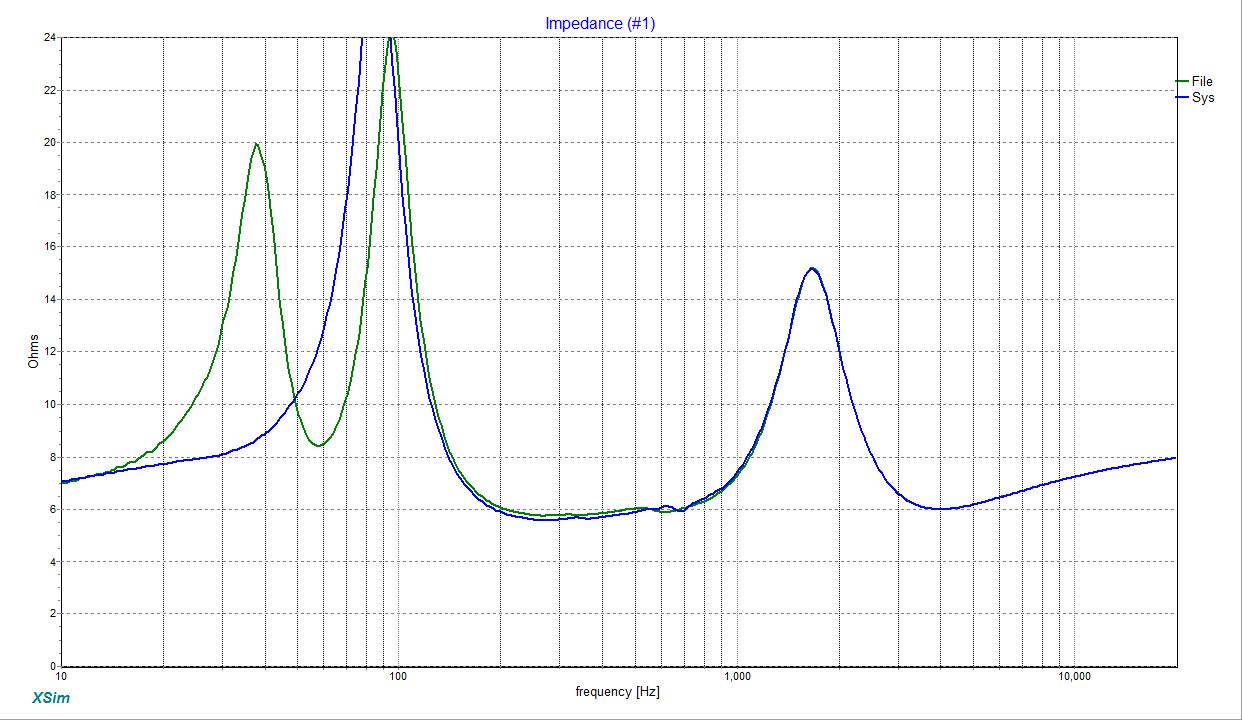Hi To All,
This is very much a newbie question and one that's probably been answered before elsewhere on this forum. But here goes, what virtues should a person look for in selecting an amplifier that will have the least amount on altering the x over and frequency response? I read somewhere that high output impedance is to be avoided. Is that correct? I'm looking for suggestions as to what amplifier specifications to look for in properly matching loudspeakers. It's time to work upstream in the signal chain and rather then make blind purchases; I thought asking a few questions here might save me some coin and buyers remorse.🙂
Best Regards,
Rich
This is very much a newbie question and one that's probably been answered before elsewhere on this forum. But here goes, what virtues should a person look for in selecting an amplifier that will have the least amount on altering the x over and frequency response? I read somewhere that high output impedance is to be avoided. Is that correct? I'm looking for suggestions as to what amplifier specifications to look for in properly matching loudspeakers. It's time to work upstream in the signal chain and rather then make blind purchases; I thought asking a few questions here might save me some coin and buyers remorse.🙂
Best Regards,
Rich
Hi Rich
Yes, low output impedance / high damping factor = smallest amplitude/ xo changes.
But, i wouldn’t connect it to = better sound. I think most will agree.
Its always complex, but if you desire simple values: SNR, THDN, low-impedance-stability, cost-no-objective-outut-relais (!), load stability, lowend bandwidth, balanced inputs, no switches/potis/vu-meter/toys, .... are way more important.
Talking bout SS amps only ...
Cheers
Josh
Yes, low output impedance / high damping factor = smallest amplitude/ xo changes.
But, i wouldn’t connect it to = better sound. I think most will agree.
Its always complex, but if you desire simple values: SNR, THDN, low-impedance-stability, cost-no-objective-outut-relais (!), load stability, lowend bandwidth, balanced inputs, no switches/potis/vu-meter/toys, .... are way more important.
Talking bout SS amps only ...
Cheers
Josh
Josh,
Thanks for your input! That gives me some ideas when making an amplifier selection.
Best Regards,
Rich
Thanks for your input! That gives me some ideas when making an amplifier selection.
Best Regards,
Rich
I don't use very low output impedance amps. Matching adjustments can be made between the amp and speaker.
AllenB,
Thanks for your reply! Could you elaborate some on your methods used to match amp to speakers?
Best Regards,
Rich
Thanks for your reply! Could you elaborate some on your methods used to match amp to speakers?
Best Regards,
Rich
Hi Montana1,
In theory, a perfect amp has zero output impedance. That is, the output frequency is load invariant. Most solid state amps behave like this above the rated minimum impedance.
However, it is also true a lot of very good amps are not so great, especially tube amplifiers that use transformer coupled outputs. The best way to illustrate this is to use the Stereophile simulated speaker load and compare a couple of amps.
First lets look at a good tube amplifier, reviewed here: Stereophile Audio Research Reference 75:

Notice the black squiggly line. That +- 1 dB variance in FR is the interaction between the simulated speaker load, and the amplifier. Compare the same test to a solid state amplifier the Pass Labs XA605:

Notice the variation is now much much smaller, +- about 0.1 dB
I am picking these amps at random, btw, haven't heard either of them. So, from a specmanship, speakers with higher and more even impedance perform better with tube amps.
Speakers with more variation in impedance, or very low impedance (i.e. ESL) perform poorly with tube amps.
However, this is somewhat of an exaggeration in the sense that your own ears matter a lot more than these charts. You should listen, but be prepared to hear this principle hold more-or-less true.
Also, it IS possible to design speakers specifically for tube amps, so that they have much more steady impedance profiles than normal. You'll read about this in reviews, I'm sure.
Best,
E
In theory, a perfect amp has zero output impedance. That is, the output frequency is load invariant. Most solid state amps behave like this above the rated minimum impedance.
However, it is also true a lot of very good amps are not so great, especially tube amplifiers that use transformer coupled outputs. The best way to illustrate this is to use the Stereophile simulated speaker load and compare a couple of amps.
First lets look at a good tube amplifier, reviewed here: Stereophile Audio Research Reference 75:

Notice the black squiggly line. That +- 1 dB variance in FR is the interaction between the simulated speaker load, and the amplifier. Compare the same test to a solid state amplifier the Pass Labs XA605:

Notice the variation is now much much smaller, +- about 0.1 dB
I am picking these amps at random, btw, haven't heard either of them. So, from a specmanship, speakers with higher and more even impedance perform better with tube amps.
Speakers with more variation in impedance, or very low impedance (i.e. ESL) perform poorly with tube amps.
However, this is somewhat of an exaggeration in the sense that your own ears matter a lot more than these charts. You should listen, but be prepared to hear this principle hold more-or-less true.
Also, it IS possible to design speakers specifically for tube amps, so that they have much more steady impedance profiles than normal. You'll read about this in reviews, I'm sure.
Best,
E
Last edited:
FYI, a long time ago I actually built the Stereophile simulated speaker load in XSim and posted it in another thread:
Simulated Speakers and Amp Z
For brevity, it may help to just take a look at the impedance of a typical 2-way system to understand what the amps are usually battling. These two lines are of the same 2-way speaker, with the port open (green) and closed (blue):

While the impedance remains relatively high (>4 Ohms) at all frequencies, those peaks may induce some FR variance.
Also, almost forgot, the amplifier does not change XO behavior in terms of crossover frequency, but they do interact due to the final speaker impedance, as seen in this chart.
Best,
E
Simulated Speakers and Amp Z
For brevity, it may help to just take a look at the impedance of a typical 2-way system to understand what the amps are usually battling. These two lines are of the same 2-way speaker, with the port open (green) and closed (blue):

While the impedance remains relatively high (>4 Ohms) at all frequencies, those peaks may induce some FR variance.
Also, almost forgot, the amplifier does not change XO behavior in terms of crossover frequency, but they do interact due to the final speaker impedance, as seen in this chart.
Best,
E
Last edited:
Most important never use a lower impedance speaker than your amp impedance rating. This is asking for trouble.
If you use a speaker with higher impedance rating than your amp you won't be able to extract the max. power out of the amp.
Therefore it is generally best to match speaker and amp impedance.
If the amp has sufficient power you can use a higher impedance speaker, this will result in a higher damping factor and more cone control although less maximum power.
Because of the low damping factor of tube amps they generally like high impedance/high sensivity speakers.
If possible I choose amp wattage=1.5-2x speaker wattage.
You can never have enough clean headroom.
If you use a speaker with higher impedance rating than your amp you won't be able to extract the max. power out of the amp.
Therefore it is generally best to match speaker and amp impedance.
If the amp has sufficient power you can use a higher impedance speaker, this will result in a higher damping factor and more cone control although less maximum power.
Because of the low damping factor of tube amps they generally like high impedance/high sensivity speakers.
If possible I choose amp wattage=1.5-2x speaker wattage.
You can never have enough clean headroom.
Hi Erik,
Thanks for your very detailed explanation! I will study the thread you referenced on simulated speakers and amp z. Just another frontier to explore.🙂
Best Regards,
Rich
Thanks for your very detailed explanation! I will study the thread you referenced on simulated speakers and amp z. Just another frontier to explore.🙂
Best Regards,
Rich
Hi globalplayer,
Thanks for your suggestions! I will be looking at purchasing an amp this coming year and will keep your recommendations in mind when making a selection. So for review, lets say the 3 way speakers I have are nominal 4 ohm; should I look for an amp with a higher damping factor (say 80-100)?
Best Regards,
Rich
Thanks for your suggestions! I will be looking at purchasing an amp this coming year and will keep your recommendations in mind when making a selection. So for review, lets say the 3 way speakers I have are nominal 4 ohm; should I look for an amp with a higher damping factor (say 80-100)?
Best Regards,
Rich
High damping factor is a advantage and will help precise bass reproduction.
Although connectors and cables will influence df greatly the value you are starting with so to speak will make a difference.
If you got 4 ohm speakers be sure the amp is also 4 ohm rated.
Also when the damping factor is specified it is usually at 8 ohms.
If you got 4 ohm speakers the damping factor will only be half of the 8 ohm value.
Although connectors and cables will influence df greatly the value you are starting with so to speak will make a difference.
If you got 4 ohm speakers be sure the amp is also 4 ohm rated.
Also when the damping factor is specified it is usually at 8 ohms.
If you got 4 ohm speakers the damping factor will only be half of the 8 ohm value.
Thanks globalplayer,
That is great information to know how amps are rated. I really appreciate your insight on this subject.🙂
Best Regards,
Rich
That is great information to know how amps are rated. I really appreciate your insight on this subject.🙂
Best Regards,
Rich
A load that varies with frequency can impose differently upon an amplifier vs frequency. This is unrelated to anything useful. It might not be an issue. If it is you can make your load appear resistive, ie constant impedance magnitude (and phase) vs frequency using passive components against your speaker (next to the amp). You would need to measure and adjust.Could you elaborate some on your methods used to match amp to speakers?
Last edited:
A Voltage source has a zero output impedance. A current source has an infinite output impedance. Different strokes..In theory, a perfect amp has zero output impedance. <snip> a lot of very good amps are not so great, especially tube amplifiers that use transformer coupled outputs.
Thanks AllenB,
I appreciate you taking the time to share your thoughts on the subject!
Have A Happy New Year,
Rich
I appreciate you taking the time to share your thoughts on the subject!
Have A Happy New Year,
Rich
Hi Rich, a perfect DIY amp in my view and considering my needs, is the one explained in G.Randy Slone's "The Audiophile's Project Sourcebook". Post #4067
Post your Solid State pics here.
Post your Solid State pics here.
Depends on what your speaker is designed for. If it is a voltage source designed speaker then low output impedance is better.
If you are going active and cross the midwoofer, midrange and above say 2 octaves above fs then a high output impedance is great. Mostly because the distortion above fs in a speaker is dependant on current so with constant current => less distortion. I did some measurements with a 6nd430 a while ago.
High output impedance does impact the frequency response though so you have to take that into account when designing the speaker.
If you are going active and cross the midwoofer, midrange and above say 2 octaves above fs then a high output impedance is great. Mostly because the distortion above fs in a speaker is dependant on current so with constant current => less distortion. I did some measurements with a 6nd430 a while ago.
High output impedance does impact the frequency response though so you have to take that into account when designing the speaker.
Allen,
Most amps attempt to be voltage sources, even tubes. Their output impedance is high, not infinite. The AR 75 I used as an example is like this.
Having said this, there has been some interesting work done on making speakers for current sources. Nelson Pass has posted a number of hypotheticals online about this.
Best,
E
Most amps attempt to be voltage sources, even tubes. Their output impedance is high, not infinite. The AR 75 I used as an example is like this.
Having said this, there has been some interesting work done on making speakers for current sources. Nelson Pass has posted a number of hypotheticals online about this.
Best,
E
Hi Lojzek,
Thanks for your post here! I will try to get my hands on the book you referenced. Very nice amplifier you built BTW!
Happy New Year,
Rich
Thanks for your post here! I will try to get my hands on the book you referenced. Very nice amplifier you built BTW!
Happy New Year,
Rich
- Status
- Not open for further replies.
- Home
- Loudspeakers
- Multi-Way
- Matching amplifier to loudspeaker question(s)